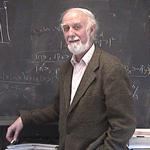
Carl Sagan liked to say, "we are all made of star stuff," referring to the fact that most of the heavy atoms that make up everything on Earth were forged in exploding stars, billions of years ago and hundreds of light years away. But where do the stars come from? We have learned that they form from vast clouds of gas and dust in interstellar space, which collapse and warm under gravity, the ashes of old stars being reborn. The study of these clouds and their composition as well as of processes that lead to cooling, collapse, fragmentation, and star formation in primordial clouds, is called molecular astrophysics. Alexander Dalgarno is the field's universally recognized leader.
Born and raised in London and educated at University College, he majored in mathematics, a subject in which he displayed rare talent. After obtaining his B.Sc. in 1947, he had a chance encounter with Sir Harrie Massey, chairman of the physics department. Massey inquired as to his post-graduation plans, and when Dalgarno admitted he had none, Massey offered him a Ph.D. fellowship in atomic physics. After Dalgarno obtained his physics doctorate in 1951, he took a position in the mathematics department at Queen's University of Belfast, where he continued his research on atomic scattering, electron-ion interactions, and energy level calculations.
Such work was directly related to studies of Earth's upper atmosphere, including its composition and how it interacts with sunlight, cosmic rays, and other radiation coming from space to form auroras and other phenomena. After moving to Harvard to join the department of astronomy in 1967, he intensified his focus on molecular astrophysics, both theoretically and through involvement in space missions. Until that time, very few molecules had been definitively identified in space, but as the space age dawned, spacecraft and new observational techniques began to reveal more about the nature of the elements scattered through interstellar space. Dalgarno began to construct mathematical models of the diffuse interstellar clouds that serve as stellar nurseries. Dalgarno's models provided the first quantitative descriptions of how these rich star-forming clouds interact with various types of radiation, how shock waves propagate through them to trigger accretion, the effects of thermal absorption and radiation, and how chemical processes play a vital role.
In 1973, Dalgarno became editor of astronomy's most cutting-edge journal of original research, Astrophysical Journal Letters. He led the Journal until 2002, guiding and expanding its prestige and influence. He also served as acting director of the Harvard College Observatory, chairman of the Harvard department of astronomy, and associate director of the Harvard-Smithsonian Center for Astrophysics, all while keeping up his own research and publishing nearly 800 widely-cited papers. He has served as a mentor and guiding figure for generations of students, many of whom have gone on to take their own places at the frontier of astrophysical research. As he once noted, if "research is a matter of overcoming obstacles," then Alexander Dalgarno has spent an illustrious career overcoming some of the most vexing obstacles in theoretical astrophysics and deepening our knowledge of the universe and our fundamental connection to its past and future.
Information as of April 2013

